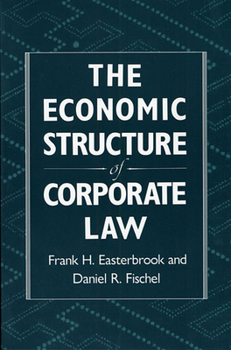The Economic Structure of Corporate Law
Select Format
Select Condition 
Book Overview
This book aims to explain - in clear, nontechnical prose - the mysteries of corporate law. Why are critical corporate decisions nearly always left to the discretion of managers, while relatively... This description may be from another edition of this product.
Format:Paperback
Language:English
ISBN:0674235398
ISBN13:9780674235397
Release Date:February 1996
Publisher:Harvard University Press
Length:384 Pages
Weight:1.20 lbs.
Dimensions:0.9" x 6.1" x 9.1"
Customer Reviews
3 ratings
CLASSICAL BOOK
Published by Thriftbooks.com User , 17 years ago
Es un libro de obligada lectura en materia de Derecho de sociedades de capital. Se puede decir que se ha convertido en pocos años en un "clásico" del Corporate Law.
A classic of the field
Published by Thriftbooks.com User , 23 years ago
Easterbrook and Fischel collected a series of law review articles into the classic text on the contractarian theory of corporate law. During the 1980s, E & F were two of the corporate law academy's enfants terribles. Their articles were provocative, yet insightful. They raised a lot of hackles, yet did ground-breaking work. Both E & F have gone on to bigger and better things. Easterbrook is now a judge on the US 7th Circuit. Fischel is dean of the UChicago law school. "The Economic Structure ..." stands as their legacy for corporate law.Like other contractarians, E & F model the firm not as an entity, but as an aggregate of various inputs acting together to produce goods or services. Employees provide labor. Creditors provide debt capital. Shareholders initially provide equity capital and subsequently bear the risk of losses and monitor the performance of management. Management monitors the performance of employees and coordinates the activities of all the firm's inputs. The firm is simply a legal fiction representing the complex set of contractual relationships between these inputs. In other words, the firm is not a thing, but rather a nexus or web of explicit and implicit contracts establishing rights and obligations among the various inputs making up the firm.The nexus of contracts model has important implications for a range of corporate law topics, the most obvious of which is the debate over the proper role of mandatory legal rules. As a positive matter, contractarians contend that corporate law in fact is generally comprised of default rules, from which the parties to the set of contracts making up the corporation are free to depart, rather than mandatory rules. As a normative matter, contractarians argue that this is just as it should be. E & F devote the bulk of this text to tweaking out these implications across an array of important topics, such as limited liability and insider trading.Their analysis is not flawless. As but a single example, E & F consistently opt for the so-called majoritarian default. Their basic thesis is that by providing the rule to which the parties would agree if they could bargain, society facilitates private ordering. Majoritarian defaults are not always desirable, however, even if a potentially dominant one can be identified. Sometimes penalty defaults are preferable. Penalty defaults are designed to impose a penalty on at least one of the parties if they fail to bargain out of the default rule, thereby giving at least the party subject to the penalty an incentive to negotiate a contractual alternative to the penalty default. They force the parties to choose affirmatively the contract provision they prefer. Penalty defaults are appropriate where it is costly for courts to determine what the parties would have wanted. In such cases, it may be more efficient for the parties to negotiate a term ex ante than for courts to determine ex post what the parties would have wanted.Having said that, however, this remain
Coase Applies; Coase is Right ...
Published by Thriftbooks.com User , 25 years ago
The classic exposition of law and economics in the corporate field. This book consolidates and expands upon several law review articles written in the early 1980s that have reshaped how corporate and securities law and policy have developed. If you want heavier economic analysis, this book is lacking, but if you want *structure* and *framework* then this book is ideal.




